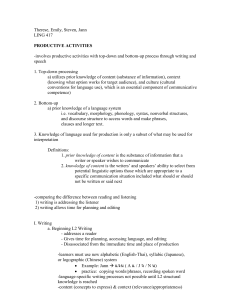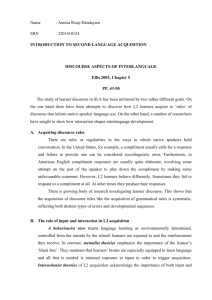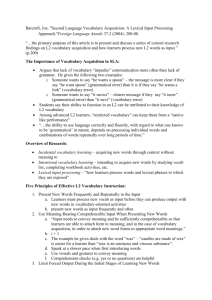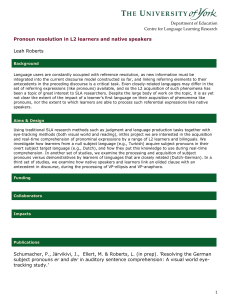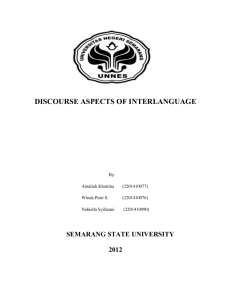Chapter 5 Discourse aspects of interlanguage Social factors do not
advertisement
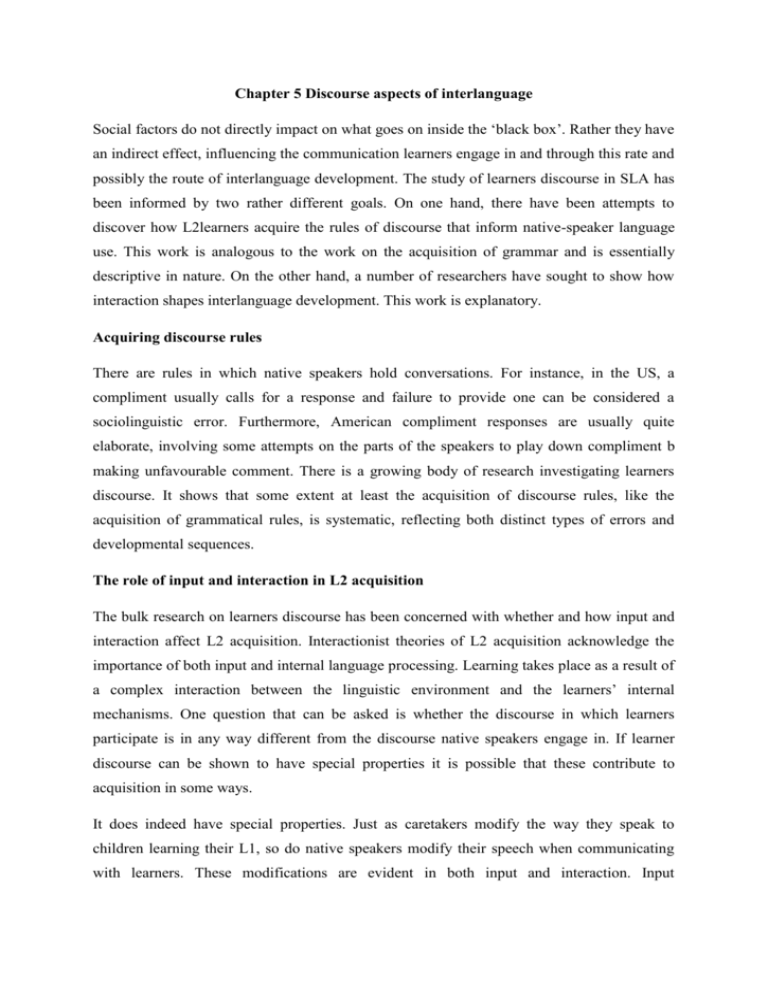
Chapter 5 Discourse aspects of interlanguage Social factors do not directly impact on what goes on inside the ‘black box’. Rather they have an indirect effect, influencing the communication learners engage in and through this rate and possibly the route of interlanguage development. The study of learners discourse in SLA has been informed by two rather different goals. On one hand, there have been attempts to discover how L2learners acquire the rules of discourse that inform native-speaker language use. This work is analogous to the work on the acquisition of grammar and is essentially descriptive in nature. On the other hand, a number of researchers have sought to show how interaction shapes interlanguage development. This work is explanatory. Acquiring discourse rules There are rules in which native speakers hold conversations. For instance, in the US, a compliment usually calls for a response and failure to provide one can be considered a sociolinguistic error. Furthermore, American compliment responses are usually quite elaborate, involving some attempts on the parts of the speakers to play down compliment b making unfavourable comment. There is a growing body of research investigating learners discourse. It shows that some extent at least the acquisition of discourse rules, like the acquisition of grammatical rules, is systematic, reflecting both distinct types of errors and developmental sequences. The role of input and interaction in L2 acquisition The bulk research on learners discourse has been concerned with whether and how input and interaction affect L2 acquisition. Interactionist theories of L2 acquisition acknowledge the importance of both input and internal language processing. Learning takes place as a result of a complex interaction between the linguistic environment and the learners’ internal mechanisms. One question that can be asked is whether the discourse in which learners participate is in any way different from the discourse native speakers engage in. If learner discourse can be shown to have special properties it is possible that these contribute to acquisition in some ways. It does indeed have special properties. Just as caretakers modify the way they speak to children learning their L1, so do native speakers modify their speech when communicating with learners. These modifications are evident in both input and interaction. Input modifications have been investigated through the study of foreign talk. There are two types of foreign talk: grammatical and ungrammatical - Grammatical foreign talk is the norm. Various types of modification baseline talk can be identified. First, grammatical foreign talk is delivered at slower pace. Second, the input is simplified. Third, grammatical foreign talk is sometimes regularized. Fourth, foreign talk sometimes consists of elaborated language use. Example: The ice-cream—you will not forget to buy it on your way home—Got it when you are coming. All right? - Ungrammatical foreign talk is socially marked. It often implies a lack of respect on the part of the native speaker can be presented by learners. It is characterized by the deletion of certain grammatical features such as copula be, modal verbs, and articles, the use of base form of the verb in place of the past tense form, and the use of special constructions such as ‘no+verb’. However, this is unlikely, as learners who experience grammatical foreign talk still manifest the same interlanguage errors as those who experience ungrammatical foreign talk. Example: Not forget buying ice-cream, eh? Input modifications of these kinds originate in the person addressing a learner. We modify the way we talk to learners to make it easier for them. However, sometimes learners still fail to understand, if it is happened, they can pretend they have understood. Learners can signal that they have not understood. This results in interactional modifications as the participants in he discourse engage in negotiation of meaning. According to Stephen Krashen’s input hypothesis, L2 acquisition takes place when a learner understands input that contains grammatical forms that are at ‘i + I’. L2 acquisition is depend comprehensible input. Michael interaction hypothesis also emphasized the importance of comprehensible input but claims that it is most effective when it is modified through the negotiation of meaning. The role of output in L2 acquisition Discourse supplies learners with the opportunity to produce language as well as hear it. Krashen argues that ‘speaking is the result of acquisition not its cause’. He claims that he only way learners can learn from their output is by treating it as auto-input. Meanwhile, Merrill Swain suggests a number of specific ways in which learners can learn from their own output. Output can serve a consciousness-raising function by helping learners to notice gaps in their interlanguages. That is by trying to speak or write in the L2 they realize that they lack the grammatical knowledge of some feature that is important for what they want to say. Second, output helps learners to test hypothesis. Third, learners sometimes talk about their won output, identifying problems with it and discussing ways in which they can be put right.
